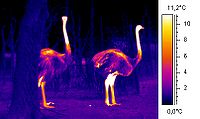
Photo from wikipedia
Perennial plant species from water-limiting environments (including climates of extreme drought, heat, and freezing temperatures) have evolved traits that allow them to tolerate these conditions. As such, traits that are… Click to show full abstract
Perennial plant species from water-limiting environments (including climates of extreme drought, heat, and freezing temperatures) have evolved traits that allow them to tolerate these conditions. As such, traits that are associated with water stress may show evidence of adaptation to climate when compared among closely related species inhabiting contrasting climatic conditions. In this study, we tested whether key hydraulic traits linked to drought stress, including the vulnerability of leaves to embolism (P50 leaf) and the minimum diffusive conductance of shoots (gmin) were associated with climatic characteristics of fourteen Tasmanian eucalypt species from sites that vary in precipitation and temperature. Across species, greater cavitation resistance (more negative P50 leaf) was associated with increasing aridity and decreasing minimum temperature. In contrast, gmin showed strong associations with aridity only. Among these Tasmanian eucalypts, evidence suggests that trait variation is influenced by both cold and dry conditions, highlighting the need to consider both aspects when exploring adaptive trait-climate relationships.
Journal Title: Tree physiology
Year Published: 2023
Link to full text (if available)
Share on Social Media: Sign Up to like & get
recommendations!